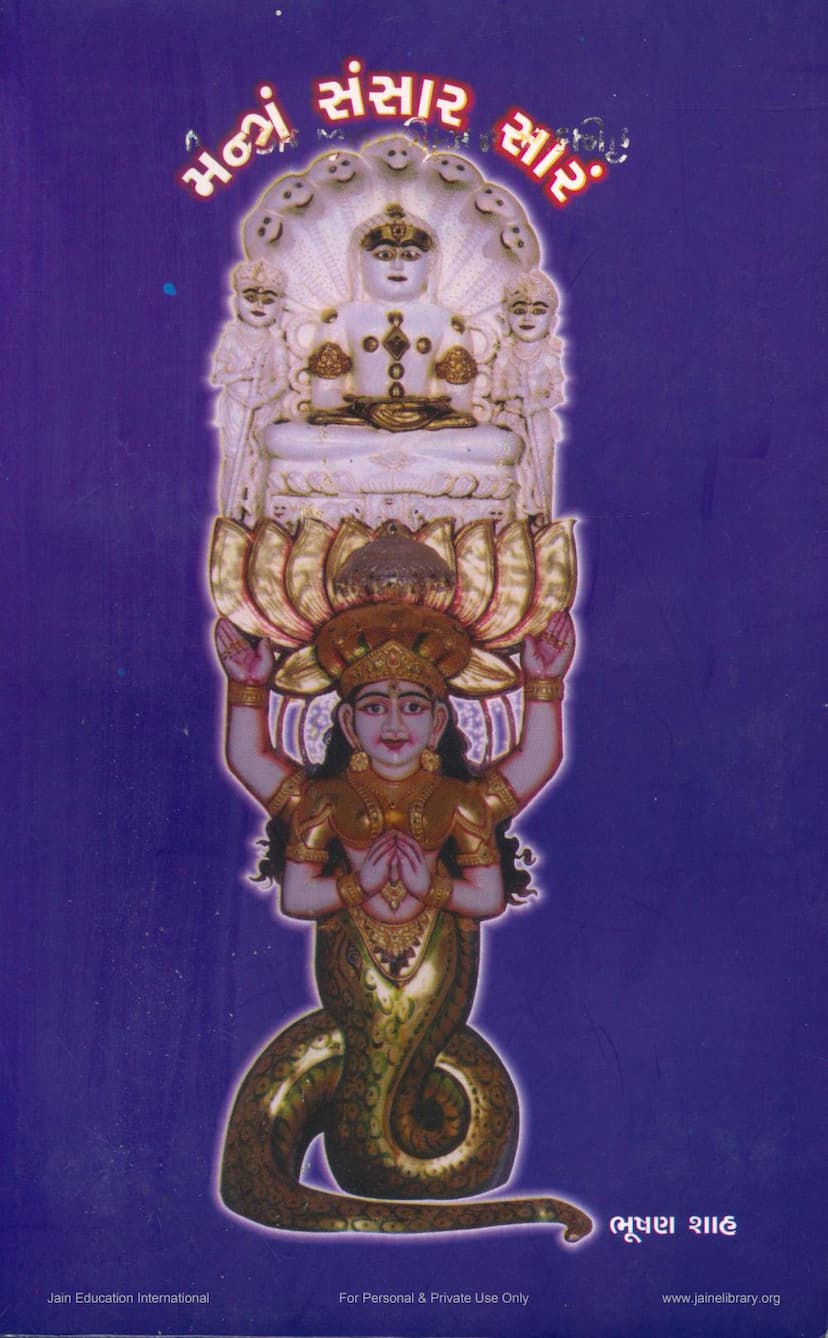Mantra Sansar Saram
Added to library: September 2, 2025

Summary
Here's a comprehensive summary of the Jain text "Mantra Sansar Saram" by Bhushan Shah, based on the provided pages:
Title: Mantra Sansar Saram (The Essence of Mantras in the World) Author: Bhushan Shah Publisher: Chandrodaya Charities
Overview:
"Mantra Sansar Saram" is presented as a significant and unique historical text within Jainism. It aims to delve into the world of Jain mantras, their efficacy, and their scientific basis, seeking to dispel the prevailing indifference or skepticism towards mantra Shastra within the Jain community. The book is a compilation of extensive research on ancient manuscripts, aiming to provide a comprehensive understanding of mantra sadhana, its powers, and its relevance, especially in the current era (Pancham Kaal).
Key Themes and Content:
-
Revival of Mantra Shastra: The book addresses the perceived neglect of mantra Shastra in Jainism. It aims to reintroduce and popularize the subject, demonstrating its importance and power, thereby encouraging people to engage in spiritual practices.
-
Scientific and Spiritual Basis of Mantras: The author attempts to bridge the gap between traditional mantra knowledge and modern scientific understanding. It highlights how concepts like hypnotism and mesmerism, which have scientific validation, are inherent in the practice of mantras.
-
Deities and Their Role (Adhishthayak Devata): A significant portion of the book focuses on "Adhishthayak Devata" (presiding deities). It explains that these deities are not mere superstitions but rather celestial beings who assist in spiritual endeavors. The text clarifies the correct understanding of these deities, debunking misconceptions and showcasing their role as protectors and helpers in the Jain tradition. It mentions examples of divine assistance from figures like Lord Rishabhdev to contemporary Acharya Buddhisagar Surishwarji Maharaj.
-
Mantra Sadhana and its Practices: The book provides detailed guidance on how to perform mantra sadhana, including when to start, specific rituals, and the importance of proper pronunciation and intention. It elaborates on specific practices like Jap (chanting), use of Yantras (mystical diagrams), and Tantra.
-
Specific Mantra and Yantra Kals: The text outlines various mantra and yantra practices, including:
- Siddhachakra: A powerful mantra and yantra associated with the Siddhachakra.
- Vardhaman Vidya: A set of mantras and practices related to spiritual attainment.
- Rishimandal: Mantras and yantras connected to the lineage of Rishis.
- Namiyun: A specific mantra practice.
- Various Tirthankar Mantras and Yantras: The book dedicates significant effort to presenting mantra and yantra rituals for all 24 Tirthankaras, emphasizing their unique powers and benefits.
- Bhaktamar Stotra: Mantras and yantras derived from the highly revered Bhaktamar Stotra.
- Surya Sahasranama: A thousand names of the Sun deity, presented with associated mantras and rituals.
- Specific Deity Mantras: Mantras and rituals for deities like Padmavati Devi, Ghantakarna Mahavir, and others are included.
-
The Power of Sound and Vibration: The book touches upon the scientific aspects of mantra chanting, explaining how specific sounds and vibrations generated through mantras can influence the mind, body, and environment. It references modern research and ancient yogic practices that explore these phenomena.
-
Importance of Guru and Tradition: The text implicitly emphasizes the importance of seeking guidance from a knowledgeable guru for performing mantra sadhana correctly, highlighting that some crucial aspects of these practices are traditionally kept secret and passed down through oral tradition.
-
Refuting Misconceptions and Criticisms: The author addresses those who dismiss or oppose mantra Shastra, arguing that practices like chanting the Navkar mantra or performing specific rituals during consecrations and in daily religious practices inherently involve mantra-like elements.
-
Dedication: The book is dedicated to the author's parents, expressing deep gratitude and reverence.
-
Structure and Scope: The book is presented as a multi-part series, with this volume being the first part, covering approximately 300 pages out of a planned 2002 pages. The detailed index reveals chapters on mantra power, siddhis, glory, science, presiding deities, necessity of deities, divine assistance, heavens, mantra sadhana methods, various Tirthankar mantras and yantras, specific deity-related practices, yantra Shastra, descriptions of seed syllables (Bijaksharas), and historical accounts related to Jainism.
-
Yantra Shastra: A significant section is dedicated to Yantra Shastra, explaining the construction, significance, and workings of various yantras, including the famous Sri Yantra and its Jain interpretations. It emphasizes the connection between yantras, mantras, and tantra.
-
Deva Loka (Abodes of Deities): The book provides an extensive description of the celestial realms, the different types of deities (Bhavanapati, Vyantar, Jyotishk, Vaimanik), their lifespans, lifecycles, and the structure of their celestial abodes (vimanas). It also details the hierarchy of deities and the specific roles of Indras.
-
Examples of Divine Intervention: The text is rich with historical and mythological accounts of deities intervening in human affairs, assisting spiritual practitioners, and protecting the Jain faith. These examples are presented to strengthen the reader's belief in the efficacy of mantra and divine grace.
Overall Objective:
"Mantra Sansar Saram" aims to be a foundational text for understanding and practicing mantra Shastra within Jainism. It seeks to instill faith, provide practical guidance, and connect ancient Jain wisdom with contemporary relevance, encouraging a deeper spiritual life and a more profound understanding of the Jain path to liberation.